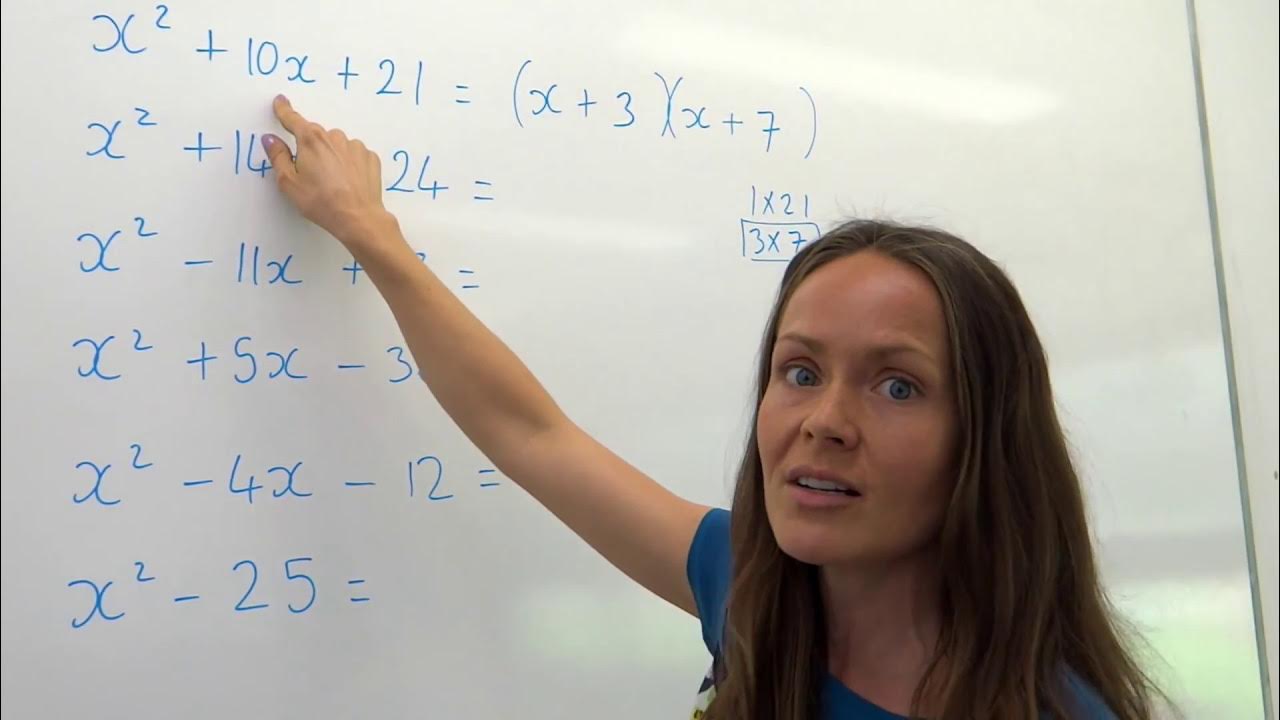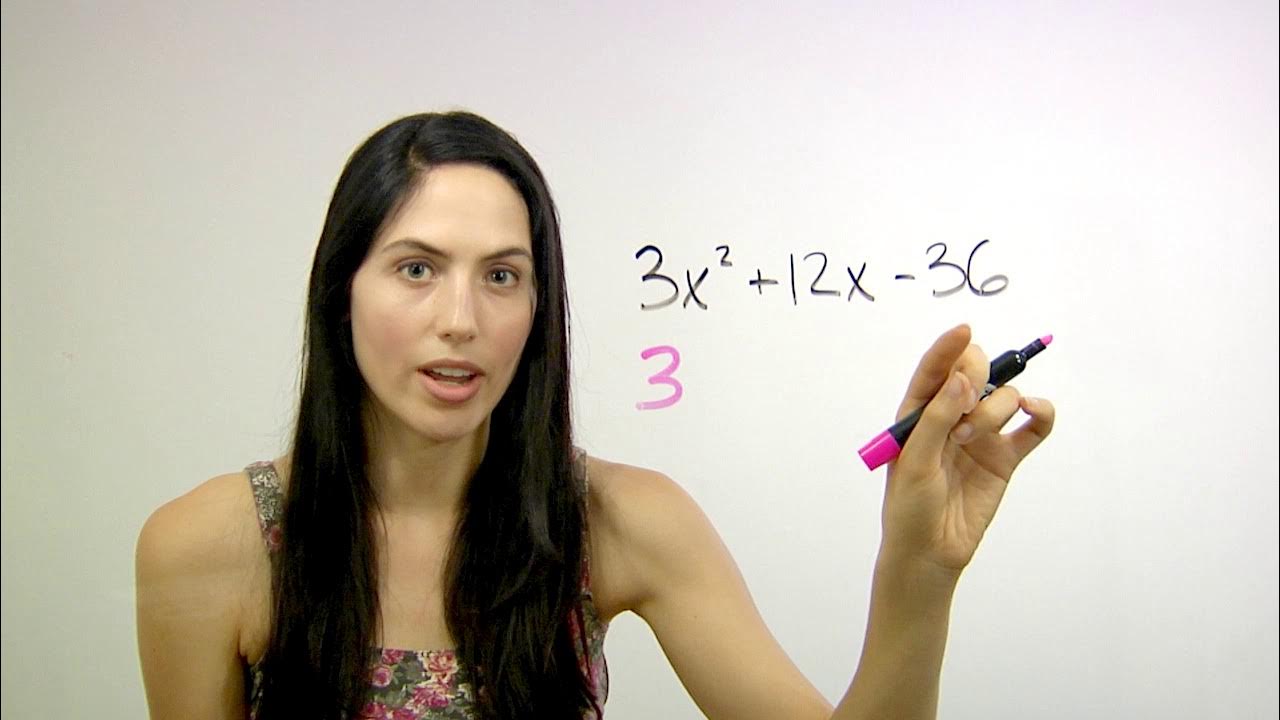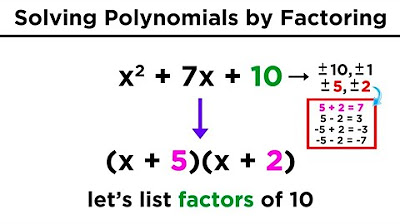Factoring Quadratic Expressions Pt. 1
TLDRThis introductory tutorial video focuses on factoring quadratic expressions with a leading coefficient of one. It explains the anatomy of quadratic expressions and demonstrates the factoring process through examples, including positive and negative constant terms. The video teaches how to identify the correct pairs of numbers that multiply to the constant term and add up to the linear coefficient, emphasizing the importance of considering both positive and negative factors when the middle term is negative. Stay tuned for the next part of the series.
Takeaways
- 📚 The video is an introduction to a series of tutorials on factoring quadratic expressions.
- 📐 The focus of the first tutorial is on quadratic expressions with a leading coefficient of one.
- 🔍 A quadratic expression is typically in the form of ax^2 + bx + c, where 'a' is the leading coefficient and 'c' is the constant term.
- ⚠️ There are special cases for when the leading coefficient 'a' is equal to one, which is the main topic of this tutorial.
- 🔑 The leading coefficient is crucial as it determines the method of factoring the quadratic expression.
- 📝 The first example provided is x^2 + 7x + 12, which demonstrates the process of factoring by finding pairs that multiply to the constant term and add up to the middle coefficient.
- 🧩 The method involves identifying two numbers that multiply to the constant (12 in the example) and add up to the middle term (7x).
- 📉 In the second example, the constant term is negative, and the tutorial explains how to consider both positive and negative factors to find the correct pair.
- 🔄 The process involves adding the factors to check if they equal the middle coefficient, with attention to the sign.
- 📈 The third example shows a scenario where the constant term is positive but the middle term is negative, emphasizing the importance of considering negative factors as well.
- 💡 A tip provided is to always check negative factors when there is a negative sign in the second or third terms of the quadratic expression.
- 👋 The tutorial concludes with an invitation to watch the next part of the series.
Q & A
What is the main topic of the introductory video?
-The main topic of the introductory video is to teach how to factor quadratic expressions with a leading coefficient of one.
What is the general form of a quadratic expression?
-The general form of a quadratic expression is ax^2 + bx + c, where a, b, and c are constants, with 'a' being the leading coefficient and 'c' being the constant term.
What are the two special cases mentioned in the script for the leading coefficient 'a'?
-The two special cases mentioned are when the leading coefficient 'a' is equal to one, which is the focus of this tutorial, and when 'a' is different from one, which will be covered in another tutorial.
How does the constant term 'c' influence the factoring of a quadratic expression?
-The constant term 'c' is determinant in the way we factor quadratic expressions, as it affects the possible pairs of factors that can be used to create the binomials for factoring.
What is the first example of a quadratic expression given in the script?
-The first example given is x^2 + 7x + 12.
How are the factors of the constant term in the first example determined?
-The factors of the constant term 12 are considered, and the pair that adds up to the middle term (7x) is chosen. In this case, the pair 3 and 4 is selected because 3 + 4 = 7.
What is the significance of the middle term in factoring quadratic expressions?
-The middle term in a quadratic expression is significant because it is the product of the outer and inner terms of the binomials when the quadratic is factored.
What is the method used in the script to determine the correct pair of factors for the constant term?
-The method involves listing the factors of the constant term and then adding each pair to see which gives the sum equal to the middle term of the quadratic expression.
What happens when the constant term has a negative number, as shown in the second example?
-When the constant term has a negative number, both positive and negative factors must be considered to find the pair that, when added, gives the middle term of the quadratic expression.
What is the tip given in the script for dealing with negative signs in the quadratic expression?
-The tip is to always check the negative factors of the constant term when there is a negative sign in either the second or third terms of the quadratic expression.
What is the third example in the script, and what is unique about it?
-The third example is x^2 - 7x + 10. It is unique because the constant term is positive, but the middle term is negative, requiring consideration of negative factors for the constant term.
Outlines
📚 Introduction to Factoring Quadratic Expressions
This paragraph introduces a new series of tutorials focused on factoring quadratic expressions, specifically starting with those having a leading coefficient of one. The anatomy of a quadratic expression is explained, highlighting the leading term, the leading coefficient, and the constant term. The importance of these components is emphasized, especially in determining the method of factoring. The tutorial begins with an example, x^2 + 7x + 12, demonstrating the process of factoring by finding two numbers that multiply to the constant term and add up to the middle term. The significance of the middle term as the sum of the products of the two numbers chosen is also discussed.
🔍 Factoring Quadratics with Negative Constants
The second paragraph continues the tutorial by addressing quadratic expressions with negative constant terms. It illustrates the process of factoring with an example that includes negative 18 as the constant, showing how to consider both positive and negative factors to find the correct pair that sums up to the middle term. The paragraph explains the selection process using a factor table and emphasizes the importance of matching the signs found in the table to the signs in the factored expression. The example concludes with the correct factorization, demonstrating the method for handling negative constants in quadratic expressions.
Mindmap
Keywords
💡Quadratic Expression
💡Leading Coefficient
💡Factoring
💡Constant Term
💡Binomial
💡Anatomy of a Quadratic Expression
💡Special Cases
💡Middle Term
💡Factors of a Number
💡Negative Constant Term
💡Positive and Negative Factors
Highlights
Introduction to a sequence of tutorials on factoring quadratic expressions.
Focus of the first video: expressions with a leading coefficient of one.
Anatomy of a quadratic expression: ax^2 + bx + c.
Explanation of terms: leading term, leading coefficient, and constant term.
Importance of the leading coefficient in determining special cases.
First example: factoring x^2 + 7x + 12.
Steps to factor: identify two numbers that multiply to the constant term (c) and add to the middle term (b).
Using pairs of factors: (1, 12), (2, 6), (3, 4) and choosing the pair (3, 4) because they add to 7.
Factoring result: (x + 3)(x + 4).
Second example: factoring x^2 + 7x - 18.
Consideration of positive and negative pairs of factors for a negative constant term.
Using pairs of factors: (1, -18), (2, -9), (3, -6), (6, -3), (9, -2), (18, -1) and choosing (9, -2) because they add to 7.
Factoring result: (x + 9)(x - 2).
Third example: factoring x^2 - 7x + 10.
Consideration of negative pairs of factors when the middle term is negative.
Using pairs of factors: (1, 10), (2, 5) and negative pairs (-1, -10), (-2, -5) and choosing (-2, -5) because they add to -7.
Factoring result: (x - 2)(x - 5).
Tip: Always check negative factors when there is a negative sign in the quadratic expression.
Conclusion and introduction to the next video in the series.
Transcripts
Browse More Related Video
5.0 / 5 (0 votes)
Thanks for rating:





